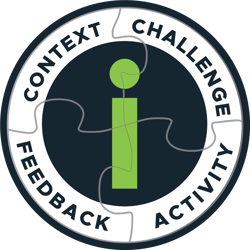

Q&A With Ethan Edwards: Creating An Impactful Learner's Journey
By Ethan Edwards | October 07, 2021 | Custom Learning | 0 Comments
Today we are excited to sit down with Ethan Edwards to answer your most pressing questions about the learner's journey, designing effective e-learning, and Allen Interactions' signature methodologies that help deliver one-of-a-kind, effective, and engaging learning experiences for your own team.
%20(900%20x%20120%20px).png?width=1500&height=200&name=2022%20CTAs%20Thin%20(600%20x%2090%20px)%20(900%20x%20120%20px).png)
I guess I might answer this with another question:
To what extent is good healing the responsibility of the patient? Or is it fully dependent on the doctor?
I don’t say this in any way to lessen the significance of your question. It is a useful comparison. I have been known to say that if we valued instruction as much as we do medicine, most designers would be guilty of malpractice.
Humans are creatures of amazing resilience. Our bodies will often heal on their own; similarly, we can learn on our own. But both of these processes can go wrong. Knowledge and experience have proven that skilled medical practitioners can provide care that makes healing likely and efficient. Regardless of patient motivation, it is the responsibility of the care provider to provide the best guidance for healing. The instructional designer bears a similar responsibility in the area of learning.
Certainly, the learner shares some responsibility, but the entire role of a designer is to create experiences that arrange for learning to occur more assuredly, more quickly, and more meaningfully than would happen otherwise. This element of instructional design is crucial and is something impossible for the naïve learner to supply.

It works the same as in any other field. CCAF doesn’t mean longer; in fact, most CCAF lessons are more streamlined in terms of having the learner engage in only Meaningful actions than comparable content-centered modules. Sales agents usually avoid wasting time that could be spent on the job making contacts, building trust, etc. When salespeople find traditional content-bound and trivia-type testing acceptable, it’s often because so little actual engagement is required and one can multi-task and use the training time to also catch up on emails or other routine tasks.
Our experience is that sales training often takes off with a new level of interest from the learners when they find responsive branching scenarios and opportunities that allow active practice rather than just passive content observation.
Creating modules that change performance isn’t “extra” or “nice to have.” It’s hard to imagine how an area so dependent on specific behaviors and practice like sales training can have any measurable impact on performance unless the learner is immersed in those activities in the training experience.
Check Out my 4 Pillars Playbook on CCAF for Creating Interactive e-Learning Instructional Designs »
%20(900%20x%20120%20px)%20(2).png?width=1500&height=200&name=2022%20CTAs%20Thin%20(600%20x%2090%20px)%20(900%20x%20120%20px)%20(2).png)
The key to providing useful Feedback is designing learner actions that identify “bugs” in the learner’s thinking or strategies.
Consider the standard A-B-C-D multiple-choice question that is ubiquitous in e-learning.
And now consider three learners.
.png?width=800&height=419&name=2024%20Blog%20Covers%20+%20Inline%20Graphics%20(2).png)
- Learner One thinks long and hard and misapplies the key principle that is the target of this learning and incorrectly picks C.
- Learner Two is confused about the task and mistakenly applies an unrelated principle from a previous lesson in picking choice C.
- Learner Three uses the rule “always pick C” as the most expedient strategy for making progress.

All three are wrong and require different Feedback to create meaningful performance change. Yet this Activity makes it impossible to distinguish these learners from each other to provide the right feedback. In class, an attentive instructor could probably infer information from body language, tone of voice, etc. to individualize the response at least slightly.
Online, better interactions would require an Activity in response to the Challenge that communicates more of what the learner is thinking. This happens automatically when the interaction chains multiple gestures together that can indicate the learner’s thoughts and strategies. Asking follow-up questions that reveal WHY learners chose the answer they did, and even the “how sure are you?” indicators shown in the webinar, provide information that would guide the e-learning module to display Feedback related to what was observed. This is why the 'A' of CCAF is so important. You can’t give Feedback related to things that were unobservable.
%20(900%20x%20120%20px)%20(3).png?width=1500&height=200&name=2022%20CTAs%20Thin%20(600%20x%2090%20px)%20(900%20x%20120%20px)%20(3).png)
All of the above. The chain of causality between training and performance and then from performance to ROI can be very tenuous. Competing factors and variations in settings can obscure any relationship that exists. So, it is important to look at results across the board to reveal ROI.
Immediate and delayed demonstrations of mastery are necessary but not sufficient measures. But mastery demonstrated through Context-rich realistic scenarios (rather than through a knowledge-based exam) at least gives some evidence the learner CAN do the task as a result of the training.
Post-training qualitative and quantitative observations of performance over time are necessary to confirm that skills demonstrated in the training transfer to the performance environment (or if the alternative on-the-job experience is superseding what was learned in training). Then, process investigation needs to verify that this specific performance is leading to higher returns when compared to workers using an alternative strategy.
So you can see, generating reliable ROI numbers is a lengthy, multi-stage, and costly process. And even then, claims of ROI may depend on some significant assumptions. It is unfortunate that the impediments make reliable ROI reports all too rare.
%20(900%20x%20120%20px)%20(4).png?width=1500&height=200&name=2022%20CTAs%20Thin%20(600%20x%2090%20px)%20(900%20x%20120%20px)%20(4).png)
It’s really difficult, especially remotely. And even if one could measure it, there is no standard by which emotions are reported.
You can ask. Some learners can assess their emotional state and so simply asking is the first step. Check out this blog here – Dr. Allen gives a great example of an onboarding training program we did with Mary Kay. It is important to provide variable response mechanisms—a slider control rather than a binary choice or a free text-entry field to describe what you are feeling rather than picking from a list.
You can observe. During user testing, you can often observe signs of anxiety, relaxation, humor, etc. by attending to changes in facial expression, body language, and mental focus. This combined with follow-up interviews can at least reveal variations and degree of emotional involvement, if not actually measure them.
This is not likely to be possible with all learners, but by pairing self-assessment data with observations, one can establish the most common “types” and degrees of emotional response and create experiences to support the emotional journey of at least a significant part of your audience.

From your question and my own experience with some stakeholders, I assume that the “fluff” you refer to is the elements related to attention to the CCAF Model and the Learner’s Journey. It’s a common view for organizations to take. If they do, though, there’s no other way of putting this, except to say that that perspective is wrong. The so-called fluff is the very heart of what makes learning even possible.
Our tasks as designers are so challenging that many decision-makers have never seen good e-learning. They assume that because so many useless page-turner lessons have been accepted as “non-fluff e-learning” for so long, that’s what the heart of e-learning modules must be—not based on any evidence but by simply accepting what has been done for so long.
We do face this pushback. In those cases, I have two challenges before me.
- First, I make sure that those business leaders are exposed to CCAF and experience-based e-learning modules. After even a quick demo, I never once had someone respond with, “That’s interesting, but I think the page-turner would be a lot more effective.”
- Second, one needs to demonstrate (and this usually takes some time because people have a hard time applying ideas without seeing them applied to their content) that experience-based designs do not make longer lessons even though they are always more fascinating. When Feedback is the primary vehicle for delivering content, lessons always become more streamlined.

Designing for accessibility is perhaps the greatest challenge in creating e-learning module experiences. To me, the paradox is that in attempting to create e-learning modules that accommodate fundamental differences in what individual learners can experience, organizations too often think that pursuing one neutral solution is the answer. I’ve never seen a situation where this achieves the best learning, but budget and time usually take precedence over learning and so resulting “accessible” designs result in interactions that produce no particular experience at all.
That having been said, the Learner’s Journey to joy and competence can be facilitated for learners with various impairments just as the rest of an e-learning module is. When setting the “tab order” of screen objects for keyboard navigation, you may want to consider the emotional impact of the order you specify as well as the logical sequence. If the visual impact of a video is too difficult to convey through verbal descriptions, consider an alternative optimized treatment that isn’t limited to a verbatim transcript of something the learner can’t perceive. Or if the emotional characteristics of an audio narration are particularly poignant, in addition to providing a text version, you may want to include some particularly meaningful images for the hearing-impaired that might otherwise not be considered necessary for communicating meaning.
The primary choice is to decide how important it is to create a Meaningful experience for each learner, in terms of knowledge, skills, and feelings, regardless of physical limitations. To do this well will require more care and individualization in crafting the journey experience.
Let's Keep This Conversation Going!
We want to extend this discussion and invite you to be a part of it! Your curiosity and diverse perspectives are what makes our e-learning development community thrive. That's why we're opening the floor for your burning questions.
Do you have queries about creating immersive learning environments? Perhaps you're curious about the integration of technology in learning design, or you're seeking advice on overcoming common learner obstacles?
Drop your questions in the comments section, and Dr. Michael Allen and our team of learning leaders might just address your query in our upcoming blogs. Together we will create an ongoing dialogue, sharing insights, fostering learning, and sparking inspiration together.

About the Author: Ethan Edwards
Ethan Edwards draws from more than 30 years of industry experience as an elearning instructional designer and developer. He is responsible for the delivery of the internal and external training and communications that reflect Allen Interactions’ unique perspective on creating Meaningful, Memorable, and Motivational learning solutions backed by the best instructional design and latest technologies.
Comments
Would you like to leave a comment?
Related Blog Posts

By: Ethan Edwards | Jun, 2015
Category: Custom Learning

By: Ethan Edwards | Apr, 2014
Category: Custom Learning

By: Ethan Edwards | Nov, 2016
Category: Custom Learning

